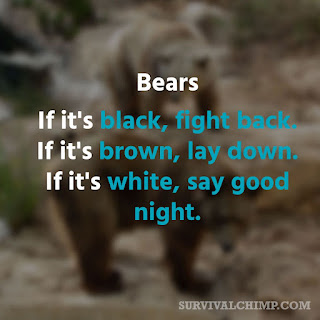In "Mishandled Conviction", Violette and her pregnant daughter flee in the forest to escape their abductor only to encounter a mama bear with her two cubs. To describe the bear encounter, I use the phrase If it’s brown, get down. If it’s black, attack. If it’s white, you’re dead, but how true is this statement?
I live in Wood Buffalo, Northern Alberta. As of August 11, there has been 134 black bear encounters in the municipality since the spring. 59% of these encounters occurred in residential areas. Late summer and fall are active months for black bears as they will eat as much as they can before going into hibernation, so that number will rise in the weeks to come.
The only bear I saw so far this summer was a cub crossing the street ten feet in front of my car. I did stop to let him cross safely, but no, I didn't get out. I didn't see his mama, but she couldn't have been far since that cub was too young to fend for himself.
In Wood Buffalo, there are only black bears, but black bears aren't always black. They come in different colours: from cream, to cinnamon, to brown, to black, and almost everything in between.
When we use the term "brown bear", we mean a grizzly bear, not a black bear with brown fur. It is actually important to know the difference between a grizzly and a black bear in order to know how to react to them.
Though grizzlies are generally bigger than black bears, you can't rely on colour or size alone to differentiate them. A grizzly has a prominent shoulder hump and an elongated face, unlike the black bear who has no obvious hump and a more rounded face. Their toes aren't aligned the same way, so their prints are different. Grizzlies also have longer claws, though I would rather not come within distance of being able to see their claws.
 So, should you fight back if you encounter a black bear, or lay down if you come across a grizzly? In most cases, that would be the right thing to do, but before you reach that point, there are a few other things to do--and not do.
So, should you fight back if you encounter a black bear, or lay down if you come across a grizzly? In most cases, that would be the right thing to do, but before you reach that point, there are a few other things to do--and not do.
First, if you see a bear, DO NOT RUN! And never turn your back to a bear.
If the bear hasn't seen you: move away cautiously.
If the bear saw you: speak calmly, wave your arm slowly, and back away. Get ready to use your bear spray, which should be clipped to your waist and not hidden at the bottom of your backpack.
If the bear charges, and your spray doesn't work, fight the black bear but lay down for the grizzly (protect your head with your arms) as you have very slim chances of winning a fight against a grizzly. That being said, if the grizzly doesn't lose interest in you after a few minutes and start biting you, you may want to fight back.
In practice, these worst-case scenarios don't happen very often. There are ways to minimize your chances of dangerous encounters: hike in groups, make noise, stay on the trails, pay attention to paw prints and scats (fresh poop means bear nearby), carry bear spray and know how to use it. Humans aren't on black bears' or grizzlies' menu, but bears will react if they are startled, if they feel threatened, if you stand in the middle of their berry patch, or heaven forbid if you come between them and their cubs.
 Bottom line: Don't be afraid to enjoy the outdoor, but stay ALERT! And don't forget, bears are good climbers.
Bottom line: Don't be afraid to enjoy the outdoor, but stay ALERT! And don't forget, bears are good climbers.
A quick note on white bears, aka polar bears: they are at the top of the food chain. No human ventures into polar
bear territory without a loaded rifle unless they want to become a midday
snack. So, if a polar bear is charging at you, and your finger isn't on the trigger, I'm afraid that bear will be the last thing you'll ever see.
For more information on how to play safely in bear country, Read the Alberta BearSmart Guide
Happy Reading & Stay Safe
JS
















